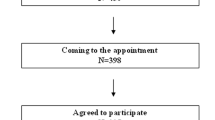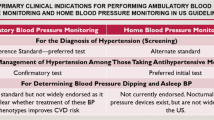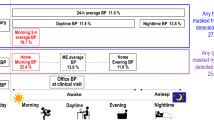Abstract
Ambulatory blood pressure (ABP) monitoring is recommended as a standard method for the evaluation of resistant hypertension (RH). This study assessed the diagnostic value of home blood pressure (HBP) monitoring in RH. Subjects on stable treatment with ⩾3 antihypertensive drugs were included. Clinic RH (CRH) was defined as elevated clinic blood pressure and true RH (TRH) as elevated ABP. The diagnosis of CRH was verified by ABP and HBP monitoring. The diagnostic value of HBP was assessed by taking ABP as reference method. Threshold for hypertension diagnosis was ⩾135/85 mm Hg (systolic and/or diastolic) for HBP and awake ABP and ⩾140/90 mm Hg for clinic blood pressure. Among 73 subjects on ⩾3 antihypertensive drugs, 44 (60%) had CRH and 40 (55%) TRH. There was agreement between ABP and HBP in diagnosing CRH in 82% of the cases (26 subjects (59%) with CRH and 10 (23%) without CRH; kappa 0.59). Regarding the diagnosis of TRH, there was agreement between ABP and HBP in 74% of the cases (36 subjects (49%) with TRH and 18 (25%) without TRH; kappa 0.46). The sensitivity, specificity, and positive and negative predictive values of HBP in detecting CRH were 93%, 63%, and 81% and 83%, respectively, and TRH were 90%, 55%, and 71%, and 82%, respectively (ABP taken as reference method). These data suggest that HBP is a reliable alternative to ABP in the evaluation of RH. These methods are necessary in both uncontrolled and controlled subjects on triple therapy to detect the white coat phenomenon and also masked RH.
This is a preview of subscription content, access via your institution
Access options
Subscribe to this journal
Receive 12 digital issues and online access to articles
$119.00 per year
only $9.92 per issue
Buy this article
- Purchase on Springer Link
- Instant access to full article PDF
Prices may be subject to local taxes which are calculated during checkout



Similar content being viewed by others
References
Calhoun DA, Jones D, Textor S, Goff DC, Murphy TP, Toto RD et al. Resistant hypertension: diagnosis, evaluation, and treatment. A scientific statement from the American Heart Association Professional Education Committee of the Council for High Blood Pressure Research. Hypertension 2008; 51: 1403–1419.
Redon J, Campos C, Narciso ML, Rodicio JL, Pascual JM, Ruilope LM . Prognostic value of ambulatory blood pressure monitoring in refractory hypertension: a prospective study. Hypertension 1998; 31: 712–718.
Brown MA, Buddle ML, Martin A . Is resistant hypertension really resistant? Am J Hypertens 2001; 14: 1263–1269.
Pickering TG . Extending the reach of ambulatory blood pressure monitoring: masked and resistant hypertension. Am J Hypertens 2005; 18: 1385–1387.
Salles GF, Cardoso CR, Muxfeldt ES . Prognostic influence of office and ambulatory blood pressures in resistant hypertension. Arch Intern Med 2008; 168: 2340–2346.
Mancia G, De Backer G, Dominiczak A, Cifkova R, Fagard R, Germano G et al. 2007 guidelines for the management of arterial hypertension: the task force for the management of arterial hypertension of the European Society of Hypertension (ESH) and of the European Society of Cardiology (ESC). J Hypertens 2007; 25: 1105–1187.
Stergiou GS, Siontis KC, Ioannidis JP . Home blood pressure as a cardiovascular outcome predictor: it's time to take this method seriously. Hypertension 2010; 55: 1301–1303.
Parati G, Stergiou GS, Asmar R, Bilo G, de Leeuw P, Imai Y et al. European Society of Hypertension guidelines for blood pressure monitoring at home: a summary report of the second international consensus conference on home blood pressure monitoring. J Hypertens 2008; 26: 1505–1526.
Stergiou GS, Bliziotis IA . Home blood pressure monitoring in the diagnosis and treatment of hypertension: a systematic review. Am J Hypertens 2011; 24: 123–134.
Stergiou GS, Salgami EV, Tzamouranis DG, Roussias LG . Masked hypertension assessed by ambulatory blood pressure versus home blood pressure monitoring: is it the same phenomenon? Am J Hypertens 2005; 18: 772–778.
Stergiou GS, Nasothimiou EG, Roussias LG . Morning hypertension assessed by home or ambulatory monitoring: different aspects of the same phenomenon? J Hypertens 2010; 28: 1846–1853.
Stergiou GS, Parati G . The optimal schedule for self-monitoring of blood pressure by patients at home. J Hypertens 2007; 25: 1992–1997.
dabls Educational Trust. Devices for blood pressure measurement. 2011. http://www.dableducational.org(accessed June 2011).
O′Brien E, Mee F, Atkins N, O′Malley K . Accuracy of the spacelabs 90207 determined by to the British Hypertension Society Protocol. J Hypertens 1991; 9 (suppl 5): S25–S31.
Baumgart P, Kamp J . Accuracy of the spacelabs medical 90217 ambulatory blood pressure monitor. Blood Press Monit 1998; 3: 303–307.
O’Brien E, Petrie J, Littler W, de Swiet M, Padfield PL, Altman DG et al. An outline of the revised British Hypertension Society protocol for the evaluation of blood pressure measuring devices. J Hypertens 1993; 11: 677–679.
Stergiou GS, Nasothimiou EG, Omboni S, De la Sierra A, Ruilope IM, Parati G . Diagnostic accuracy of home blood pressure monitoring: the MEDIT HABP study (Mediterranean home vs Ambulatory BP). J Hypertens 2011 29 (e suppl A): e 83.
Stergiou GS, Baibas NM, Gantzarou AP, Skeva II, Kalkana CB, Roussias LG et al. Reproducibility of home, ambulatory, and clinic blood pressure: implications for the design of trials for the assessment of antihypertensive drug efficacy. Am J Hypertens 2002; 15: 101–104.
Muxfeldt ES, Bloch KV, Nogueira AR, Salles GF . Twenty-four hour ambulatory blood pressure monitoring pattern of resistant hypertension. Blood Press Monit 2003; 8: 181–185.
Oliveras A, Armario P, Hernández-Del Rey R, Arroyo JA, Poch E, Larrousse M et al. Urinary albumin excretion is associated with true resistant hypertension. J Hum Hypertens 2010; 24: 27–33.
Muxfeldt ES, Bloch KV, Nogueira Ada R, Salles GF . True resistant hypertension: is it possible to be recognized in the office? Am J Hypertens 2005; 18: 1534–1540.
Pierdomenico SD, Lapenna D, Bucci A, Di Tommaso R, Di Mascio R, Manente BM et al. Cardiovascular outcome in treated hypertensive patients with responder, masked, false resistant, and true resistant hypertension. Am J Hypertens 2005; 18: 1422–1428.
Oikawa T, Obara T, Ohkubo T, Kikuya M, Asayama K, Metoki H et al. Characteristics of resistant hypertension determined by self-measured blood pressure at home and office blood pressure measurements: the J-HOME study. J Hypertens 2006; 24: 1737–1743.
Marui FR, Bombig MT, Francisco YA, Thalenberg JM, Fonseca FA, Souza DD et al. Assessment of resistant hypertension with home blood pressure monitoring. Arq Bras Cardiol 2010; 95: 536–540.
Acknowledgements
The home devices used in the study were provided by G Leoussis IS, Athens, Greece.
Author information
Authors and Affiliations
Corresponding author
Ethics declarations
Competing interests
The authors declare no conflict of interest.
Additional information
This paper was presented at the 20th European Society of Hypertension Meeting, Oslo, 2010.
Rights and permissions
About this article
Cite this article
Nasothimiou, E., Tzamouranis, D., Roussias, L. et al. Home versus ambulatory blood pressure monitoring in the diagnosis of clinic resistant and true resistant hypertension. J Hum Hypertens 26, 696–700 (2012). https://doi.org/10.1038/jhh.2011.98
Received:
Revised:
Accepted:
Published:
Issue Date:
DOI: https://doi.org/10.1038/jhh.2011.98
Keywords
This article is cited by
-
Role of home blood pressure monitoring in resistant hypertension
Clinical Hypertension (2023)
-
Prognostic Importance of Ambulatory Blood Pressure Monitoring in Resistant Hypertension: Is It All that Matters?
Current Hypertension Reports (2016)
-
What is the evidence base for diagnosing hypertension and for subsequent blood pressure treatment targets in the prevention of cardiovascular disease?
BMC Medicine (2015)
-
Use of ambulatory blood pressure measurement in the definition of resistant hypertension: a review of the evidence
Hypertension Research (2014)



